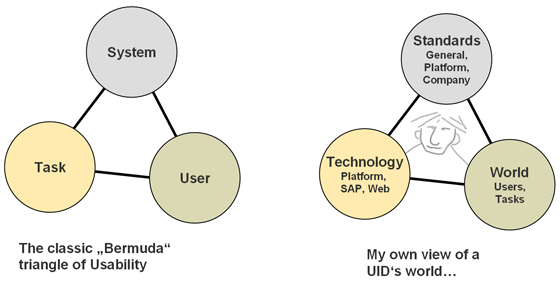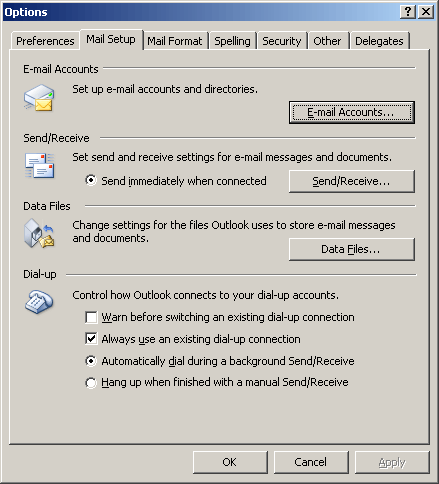Some Thoughts on Creativity
By Gerd Waloszek
To overview of UI Design Thoughts
There is currently much ballyhoo around "creativity" and "innovation" in my company. As usual, I am somewhat skeptical regarding this excitement. I do not argue that creativity is not needed in designing professional user interfaces – it is, but in a much more constrained fashion than designers generally assume.
Creativity and Constraints
In my talk at the University of Applied Sciences Design in Potsdam at an "Germany, Land of Ideas" event, I was quick to point out that there are hugh differences with respect to the degree of so-called "creative freedom" between "usual" designers and user interface designers at a software company. Let me reiterate some of the points I made.
First, the work of user interface designers is very much constrained by standards. There are international, general standards, such as ISO 9241, which provide a general framework for user interface design, one of them being conformity to users' expectations Then there are platform standards, such as Apple's Human Interface Guidelines or the Windows styleguide, which mostly cover the building blocks of user interfaces as well as the basic interaction (e.g. how cut-and-paste is used, how the respective functions are called, where they are located, etc.). And last, but not least, there are company-specific standards, which go beyond these by coverings company-specific screen elements as well as business-related functionality.
Secondly, there are technical constraints. That is, an application is built on a certain technical platform. When building user interfaces, user interface designers have to use the library of screen elements that this platform offers. They also have to take its special features as well as its restrictions into account. This also extends to the interaction itself. Sadly enough, but user interface designers cannot "shop" at other platforms and buy what they would like to have in their user interfaces...
Thirdly, and most important, there are the users and their tasks. In "classic" diagrams showing the basic elements that the field of human-computer interaction (HCI) has to deal with, you will find three cornerstones: (1) the system (which is my second item), (2) the user, and (3) the task (figure 1, left). My own view of "an user interface designer's world" looks a little different: It includes the diverse standards that have to be obeyed (figure 1, right). When asking myself, which element is the most most relevant one for design, I often "see-saw" between user and task. At one point in time, I find the user, at another I find the task most relevant. Currently, I lean towards the task because it determines the basic features of a design.

Figure 1: The classic usability triangle and my own view
Users versus Designers
User-centered design put the user at the center because users are the "final judges" who determine whether a design is successful or not. But what does this mean with respect to the designers' creativity? In my opinion, it implies that designers have to step back and place the users' requirements on top, not their own needs, such as the desire to create outstandingly creative and innovative designs. Therefore, I was fairly astonished when I read this remark from Clarisse Sieckenius de Souza:
- "Interestingly, all the user-centered mantras in HCI have repeated the need to know the users. This is undeniably a fundamental requirement for designing good products. But we have never seen a suggestion that users should know designers." (From The Semiotic Engineering of Human-Computer Interaction, 2005)
Perhaps she is right. If users would better know the needs and desires of designers, such as their quest for demonstrating their creativity, users would perhaps moan less about bad designs and would put more effort in the understanding of software applications (and electronic devices in general). Sorry, I am a bit sarcastic now...
As I already mentioned, conformity to users' expectations is one of the requirements of the ISO norms. This is probably not a design goal that most designers would strive for, at least not as long as they are at universities, in famous design institutions, or in "hip" design agencies. Instead, they strive for new solutions – which is often equated with being creative and innovative – and rightly so. But their part of the universe is different from that of user interface designers in a company creating and selling business software. Of course, user interface designers or even developers have the potential of being creative, too, for example, use design elements in innovative ways. I often told the story of a developer who used checkboxes instead of radiobuttons because he thought that checkboxes look nicer. But probably the users would not have appreciated his creativity...
Figure 2: Confusing or not? Click image to see the original popup
Conclusion
To sum up, does all this mean that user interface designers in a professional software company are not creative or are not allowed to be creative? To the latter, I would answer: "Yes, and no." They are, indeed, not allowed to be creative in ways similar to using checkboxes instead of radiobuttons – they would severely clash with established UI standards. On the other hand, there are overwhelmingly many opportunities for showing creativity and innovation in a company. But as a professional user interface designers we have to be aware of our constraints: users, tasks, (UI) technology, and standards.
Originally published: 01/25/2007 - Last Revision: 02/01/2009
Gerd Waloszek |
made by |

